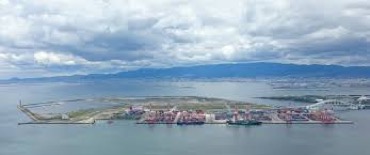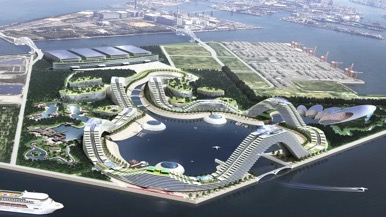Questions
What are the real estate trends and goals in Osaka? What problems is the Osaka real estate market currently facing? How is Osaka attempting to solve these problems and achieve its goals?
Discussion
Recently, Osaka has been presented as a rich environment for real estate investments for a multitude of reasons. But upon deeper investigation, the city’s real estate market is juggling two very different issues—a rapidly expanding city center and increasingly decrepit suburban neighborhoods.
First and foremost, there is an increasing demand for space from tourism and commerce in Osaka. Recent economic policies under Prime Minister Abe have relaxed visa regulations for those visiting from Asia, creating a boom in tourism (White, “Tourism in Osaka”). Additionally, some experts suggest that Japan is also seen as a “safe haven” for investors. According to Akihiko Mizuno (Head of Capital Markets, JLL Japan), “with growing political uncertainty around the world, overseas capital has increasingly viewed Japan as a safe haven” as Japan poses little geopolitical risk. It is also considered a safe haven for wealthy individuals in Asia as in Japan foreigners can purchase freehold land (Mizuno,“Overseas Investors”). Before the coronavirus, Osaka city officials planned to convert Yumeshima, a large scrap heap in Osaka bay, into the site of the 2025 World Expo, with additional construction if Osaka can win the bid to host Japan’s first casino resort. Robin Harding explains that the site has already received about ¥280bn(~$2.6bn) in government and private investments. According to Harding, it is also projecting about 28 million visitors for the expo and expects about ¥82bn in revenue from ticket sales alone (Harding,“Osaka Dreams Big”). However, with the virus still raging globally, it is uncertain whether or not this project will be completed on time or at all.
With the approaching Olympics increasing tourism and investments in Japan, and Tokyo simultaneously running out of space, investors and buyers in the 2010s were left facing ever increasing prices (Akagi, “Why Osaka Is Winning”; Fischler, “House Hunting in Japan”). This led Osaka to accept the overflow, with the result that the city experienced almost the full brunt of the tourism boom. Osaka was making the most of this boom by investing in infrastructure and advertising itself as Japan’s one-stop-shop. Geographically, Osaka offers quick access to Kyoto and Nara and so served as an increasingly popular destination for tourists from other parts of Asia, specifically tourists from China (White, “Tourism in Osaka”). However, it is possible to have too much of a good thing. With such overwhelming demand, Osaka is also faced the prospect of running out of space and of rising prices, much like Tokyo (Mizuno,“Overseas Investors”). Retailers in Osaka have tried to maintain sustainable growth now that the consumer market has slowed down and shifted more towards less expensive products and purchasing experiences like spas and beauty counseling (White, “Tourism in Osaka” ).
In contrast, outside of major development projects in the city proper, Osaka has actually been facing some major issues in real estate when it comes to housing in suburban areas. In Japan, most residential buildings actually hold little to no value and only depreciate overtime. Only the land consistently holds value, while the Japanese real estate market expects homes to last about 20-30 years before they need to be torn down and rebuilt. Due to constantly changing building codes, especially with regard to earthquake safety, homes are often torn down and rebuilt when they change hands (Berg, “Raze, Rebuild, Repeat”). However, this process of constantly tearing down and rebuilding houses is not only unsustainable, but also expensive. As such, nowadays young couples, who are typically making less money than were common when the economy was booming, are starting to choose to live in older homes and simply refurbish them (Berg, “Raze, Rebuild, Repeat”).
Besides buildings that are being torn down, there are also buildings that are simply lying empty. Berg cites research by Nomura Research Institute establishing Japan’s vacancy rate at about 13%. The explanation is that as Japan’s population ages, many older residents of Japan’s suburbs are living in assisted living facilities or with their children, and an increasing number of young people are fleeing rural towns and suburbs for the city (Berg, “Raze, Rebuild, Repeat”). This leaves many neighborhoods in Japan partially empty and increasingly decrepit. One promising plan was headed by Mitsuhiro Tokuda, an architecture professor at Kyushu Institute of Technology. This project, which started as a simple survey with his students, turned into a business for Tokuda that involved partnering with property owners to convert their buildings into new spaces; bringing them new purpose and revitalizing the town (Berg, “Raze, rebuild, repeat”). While still relatively local, this shows a promising solution to a problem that has been plaguing Japan’s more rural suburbs for quite some time.
Currently, Osaka is at a point where it could make or break under the strain of meeting market demands. While their ever innovative solutions and mega projects offer some hope, with the coronavirus recently reaching pandemic levels, and so much of Japan’s real estate market depending on investments and tourism coming from China, other parts of Asia, and the United States, many of Osaka’s greatest hopes for revival and success hang on the precipice.
Sources
Akagi, T. “Why Osaka is winning investment in Japan”. JLL The Investor, 2018. https://www.theinvestor.jll/news/japan/others/osaka-winning-investment-japan
Berg, N. “Raze, rebuild, repeat: why Japan knocks down its houses after 30 years”. The Guardian, 2017. https://www.theguardian.com/cities/2017/nov/16/japan-reusable-housing-revolution
Fischler, M. “House hunting in Japan: A modern ski cabin in the woods”. New York Times, 2020. https://www.nytimes.com/2020/02/26/realestate/house-hunting-in-japan-a-mod ern-ski-cabin-in-the-woods.html
Harding, R. “Osaka dreams big with 2025 World Expo and casino plans”. Financial Times, 2019. https://www.ft.com/content/93c79036-4a3a-11e9-bde6-79eaea5acb64
Mizuno, A. “Overseas investors look to regional Japan”. JLL The Investor, 2017. https://www.theinvestor.jll/news/japan/others/overseas-investors-look-regional- japan/
White, S. “Tourism in Osaka, often overshadowed by Tokyo, is catching up”. Reuters, 2019. https://www.reuters.com/article/us-japan-economy-osaka/tourism-in-osaka-often-overshadowed-by-tokyo-is-catching-up-idUSKBN1QS2TK





